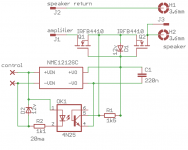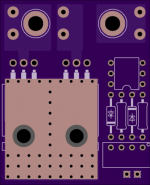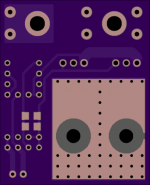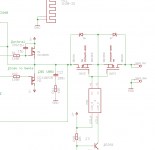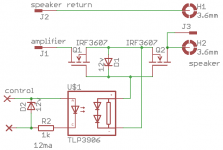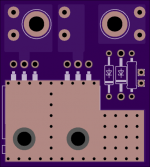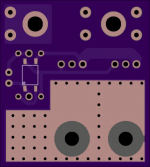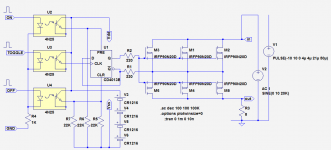Up till now, I've been using relays to protect loudspeakers. I must say I'm uneasy about using parts underrated for the job (most relays DC current ratings are terrible).
Uneasy enough to consider replacing the relays by a mosfet based solution. Would the following schematic seem ok ? Inspiration comes from the esp pages on driving ssr. Rod Elliot dismisses the dc-dc solution because of cost but a 1W murata is now less than 6€. Add a pair of irfb4410 (8m rdson @10Vgs), a cheap opto and you're set for 10€ (pcb excluded)
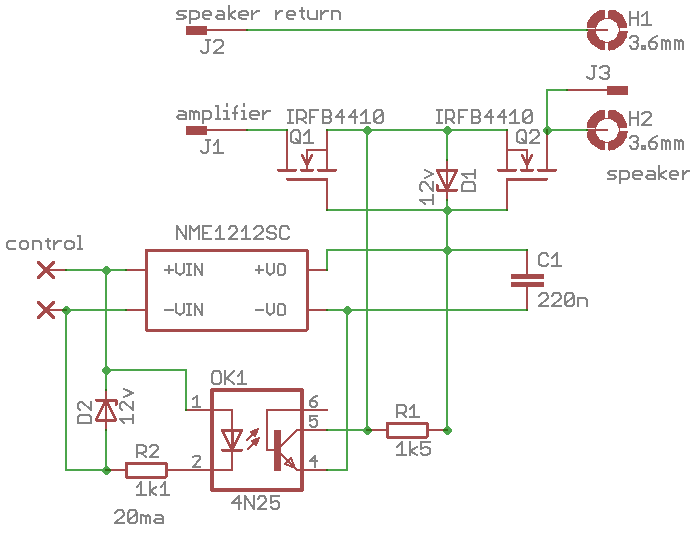
The requirements are:
- it can be used as a direct replacement to a relay, controlled by an existing offset protection board (in my case, based on the esp33). Just a pair of wires to run.
- it is made to be used with amps with up to +/-50vdc rails.
- it is made to be directly mounted on binding posts with 3/4" spacing.
- it is made with parts in stock at Reichelt (ease of ordering).
Any trap I've fallen into ?
Uneasy enough to consider replacing the relays by a mosfet based solution. Would the following schematic seem ok ? Inspiration comes from the esp pages on driving ssr. Rod Elliot dismisses the dc-dc solution because of cost but a 1W murata is now less than 6€. Add a pair of irfb4410 (8m rdson @10Vgs), a cheap opto and you're set for 10€ (pcb excluded)
The requirements are:
- it can be used as a direct replacement to a relay, controlled by an existing offset protection board (in my case, based on the esp33). Just a pair of wires to run.
- it is made to be used with amps with up to +/-50vdc rails.
- it is made to be directly mounted on binding posts with 3/4" spacing.
- it is made with parts in stock at Reichelt (ease of ordering).
Any trap I've fallen into ?
Attachments
Definitely do it, MOSFET is the correct way to protect a speaker from DC IMO. It has initially lower resistance (with low Rds MOSFETs chosen) and maintains this value throughout its life, is actually capable of breaking a DC fault current and can do so repeatedly, acts much faster, cheaper than a relay with remotely comparable performance for this task and with modern parts can even be simpler to implement.
Which brings me on to the PVI, or photovoltaic isolator. While your circuit should work I'd simply replace the DC-DC and opto with a cheap PVI like the APV1121, this generates a decent voltage drive of very low current and this device even includes a fast turn-off circuit inside, which is where switching speed counts! Even if you use very high input capacitance MOSFETs then turn-on time will still be faster than a conventional relay.
Attached is the MOSFET muting relays I use in my amplifier, it's been in service for several months now and performs flawlessly. The only small caveat is that 'off' isolation will be relatively poor at very high frequencies due to MOSFET Coss, you can select to minimise this somewhat. In practise it's not an issue, it blocks any turn on/off noises and blocks DC entirely. Good luck
Which brings me on to the PVI, or photovoltaic isolator. While your circuit should work I'd simply replace the DC-DC and opto with a cheap PVI like the APV1121, this generates a decent voltage drive of very low current and this device even includes a fast turn-off circuit inside, which is where switching speed counts! Even if you use very high input capacitance MOSFETs then turn-on time will still be faster than a conventional relay.
Attached is the MOSFET muting relays I use in my amplifier, it's been in service for several months now and performs flawlessly. The only small caveat is that 'off' isolation will be relatively poor at very high frequencies due to MOSFET Coss, you can select to minimise this somewhat. In practise it's not an issue, it blocks any turn on/off noises and blocks DC entirely. Good luck
Attachments
I ordered up the same irfb3607Is it really as simple as this ?
I switched to irf3607. Same rdson, only 75v but much cheaper and lower capacitance.
Still not used any to build SS relays. I must try harder, but still can't get decent PCB traces from any of my laser printers.
4 went into the NX (Bonsai) amplifiers.
Last edited:
Is it really as simple as this ?
I switched to irf3607. Same rdson, only 75v but much cheaper and lower capacitance.
Yes.
Can you really get away with such minimal heatsinking? Is dissipation very low if devices are either fully on or fully off?
Yes.
I used IRF2907 having RDS(on) = 4.5mΩ
http://www.diyaudio.com/forums/solid-state/191449-output-relays.html#post2659578
Is it really as simple as this ?
I switched to irf3607. Same rdson, only 75v but much cheaper and lower capacitance.
Remember a TVS across the mosfets to protect them, there can be some nasty spikes from those big inductors (also called speakers....)
D1 is not really needed.
Is a TVS required to pass the back emf?Remember a TVS across the mosfets to protect them, there can be some nasty spikes from those big inductors (also called speakers....)
D1 is not really needed.
These big mosFETs have a built in diode across each D to S
Body diode rating 80A continuous and 310A peak for the 3607.
Is a TVS required to pass the back emf?
These big mosFETs have a built in diode across each D to S
Body diode rating 80A continuous and 310A peak for the 3607.
Yes, a bidir TVS are required to protect the mosfets, diodes only conduct in one direction....
Here is an example of bistable MOS relay I developed many years ago.
The Li batteries need to be present, but they will last forever since no current is drawn under normal conditions.
I have also developed a complete speaker protection system based on MOS:
http://www.diyaudio.com/forums/solid-state/255609-s-p-autonomous-speaker-protection-system.html
The Li batteries need to be present, but they will last forever since no current is drawn under normal conditions.
I have also developed a complete speaker protection system based on MOS:
http://www.diyaudio.com/forums/solid-state/255609-s-p-autonomous-speaker-protection-system.html
Attachments
Rethinking this tvs issue.
If I put the tvs accross the mosfet, the working voltage has to be equal or superior to the rails of the amplifier, to avoid the tvs conducting in case of a fault.
Let's take a 50V rail amplifier. In that case, the first bidirectionnal tvs with a >50v Vrm is a 68V nominal tvs. Breakdown voltage is between 65 and 71V. Clamping only 92V.
So, for a +/-50V supply, we need a 68V tvs and a 100V mosfet, right ?
PS: this might be a bit conservative. A 56v nominal tvs with a working voltage of 47V, a minimum breakdown voltage of 53V and a clamping voltage of 77V might enable the use of a 75V mosfet.
If I put the tvs accross the mosfet, the working voltage has to be equal or superior to the rails of the amplifier, to avoid the tvs conducting in case of a fault.
Let's take a 50V rail amplifier. In that case, the first bidirectionnal tvs with a >50v Vrm is a 68V nominal tvs. Breakdown voltage is between 65 and 71V. Clamping only 92V.
So, for a +/-50V supply, we need a 68V tvs and a 100V mosfet, right ?
PS: this might be a bit conservative. A 56v nominal tvs with a working voltage of 47V, a minimum breakdown voltage of 53V and a clamping voltage of 77V might enable the use of a 75V mosfet.
I must try harder, but still can't get decent PCB traces from any of my laser printers
I silkscreen my PCBs and sometimes use photopositive boards for quick but Pro looking prototypes, in either case laser is not dark enough, have varying density (edges are good, larger areas are grey, not black) and pinholes, but I print on mylar transparencies and stack 2 of them, results are perfect.
Now if you want iron-on transfer, for good results you need a late model laser with a fresh original cartridge, the inexpensive Samsungs are excellent and merit buying one just for PCB work, keep the old ones for standard paper printing
Of course, justified only if you regularly make custom PCBs
In principle, yes, but it wouldn't be a very optimal choice: because they are P devices, the polarity of the controls would be reversed (ON becomes OFF and vice-versa) which is no big deal, but P devices suffer from a higher Rdson, everything else being equal.Elvee,
Very nice! Thank you.
I have lots of IRFP9240 - can that work?
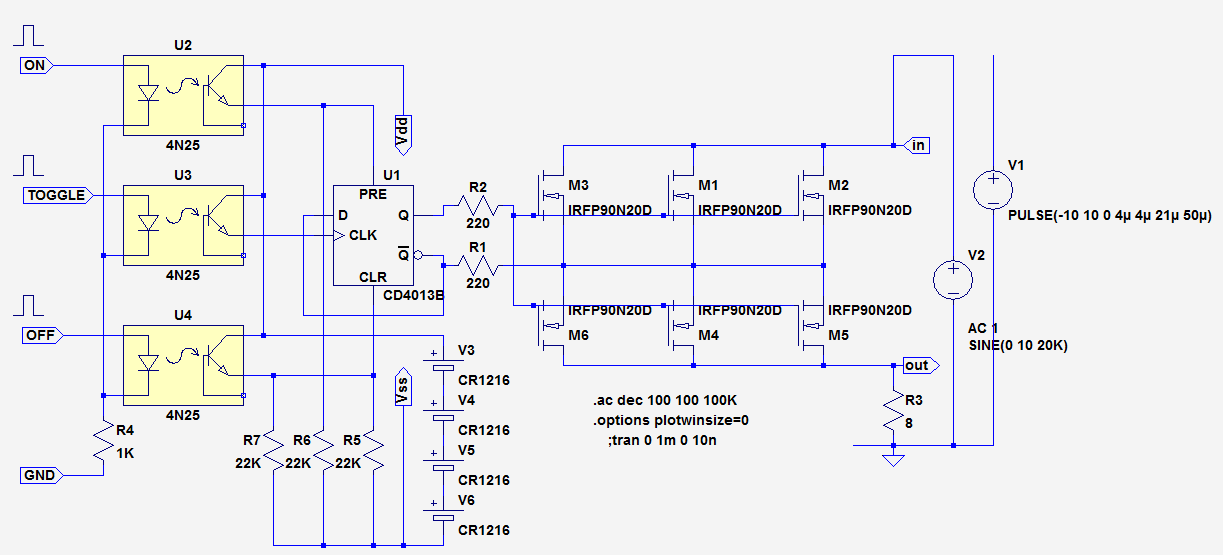
Of course, if you have buckets of IRFP9240, that's no obstacle
- Status
- This old topic is closed. If you want to reopen this topic, contact a moderator using the "Report Post" button.
- Home
- Amplifiers
- Solid State
- Mosfet-based replacement for loudspeakers relays
